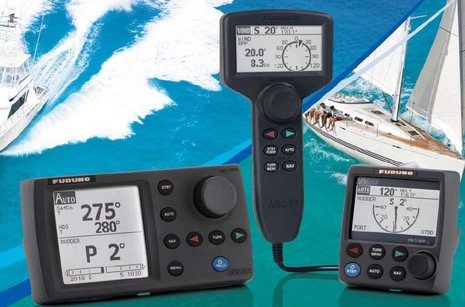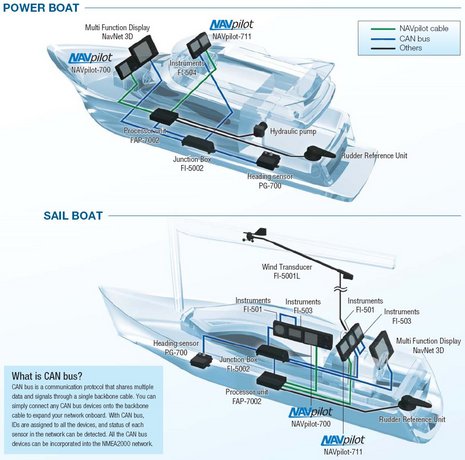Furuno NAVpilot 700 Series, w/ CANbus
Just as with the nifty-looking new RD- and GP-33 color 4.3-inch displays, Furuno Japan is ahead of FurunoUSA in announcing the new NAVpilot 700 series. (Sorry, Klamath, but if it’s on the Web somewhere, some Panbot is apt to find it — thanks, Frank! — and I feel obliged to write about it ;-). Aside from the brochure downloadable at that link, the most information I’ve found so far is a press release at the Australian Furuno distributor, which discusses a “unique Fish Hunter Mode” as well how highly sailboats figure on the feature list. While I’m not sure such features are new relative to the existing NAVPilot 500 series, the use of CANbus (aka NMEA 2000, an unfortunate word game we discussed here) in the three control heads and the processor definitely is. But the brochure diagram has me scratching my chin…
Autopilots are great for demonstrating the value of NMEA 2000 (based on CANbus, or CAN bus that happens to carry NMEA 2000 messages, or SimNet, or SeaTalkNG, or whatever you want to call it). The AP processing unit needs input from high speed heading, rudder angle, and maybe wind direction sensors, as well as interfaces with control heads and MFDs. Before N2K, that often meant a separate cable for every one of those tasks, often multiple data protocols, often a challenge of an installation. But with NMEA 2000, all those connections can be made with drops from a standard backbone running through the boat and using mostly standard data messages.
Which is no doubt why Furuno now joins Raymarine, Simrad, and Garmin in offering autopilot systems with heads and processors that can use N2K. But then what the heck are those green “NAVpilot cables” connecting the heads and the FAP-7002 processor in these system diagrams? The brochure describes NMEA 0183 and CAN bus inputs/outputs on those heads, and all sorts of standard 0183 and 2000 messages they handle. Is Furuno using its CANbus in an unusual one-to-one fashion here, and, if so, why? We need “Furuno Tech” to show up in the comments section again, please (and also to help us sort out the issues raised in the recent entry about NN3D and MaxSea TimeZero).















In case readers get confused about where the NMEA 2000 backbone is in those diagrams, it’s all within those FI-5002 junction boxes, terminators included. It could be done a different way, for sure, but Furuno seems to favor those boxes:
https://panbo.com/archives/2008/09/actisense_furuno_n2k_junction_boxes_impressions.html
It looks to me like there is a new heading sensor, but the same old rudder reference unit. And since the control unit still has a dedicated cable, it appears that at most this configuration might eliminate one cable (i.e., the heading sensor). And no wireless control head.
The previous model allowed a separate 183 feed to be displayed on the control head which I found very useful for a stern depth sounder (very reassuring when mooring Med style). Since the Furuno MFD cannot accomodate that, the 700 series may be a step backwards.
But does the 7000 processor bridge 183/N2K data? The Raymarine control heads/computers do not, so N2K data can’t be displayed on a 6000 series head, and 183 data can’t be displayed on an ST80 head.
Anyone heard of compatibility with prior generations?
I sold a Navpilot with a control box 711. It has no connection Micro-C and must be connected directly to FAP7002.
http://www.discount-marine.com/club/image/benoit/furuno-navpilot-711
The remaining sensors (PG700, FI50 wind) are connected to the NMEA2K backbone without junction box.
If the diagram is consistent with their other marketing literature, then the green lines represent ethernet connections. The connections for the rudder reference unit and masthead sensor are not NMEA 2000.
The brochure specifications for the three NAVpilot 700 series control heads says 1 CANbus and 2 NMEA 0183 ports. If “Furuno CANbus” usually means an N2K-like micro NMEA2000 plug/cable that can drop to a regular backbone, but sometimes doesn’t mean that, it’s sure going to be confusing.
As for the non N2K rudder and wind sensors, I think regular N2K sensors would work too. Certainly the Furuno Wind messages coming out of their FI-50 instrument is standard N2K, so I can’t imagine that processor would distinguish those of from any other wind PGNs.
The owner’s manaul for the 700 series is here:
http://www.furuno.se/uploads/tx_vtfuruno/NAVpilot_700_711_720_02.pdf
Can the furuno 711c be installed on a 44′ inboard sailboat without the RRU?